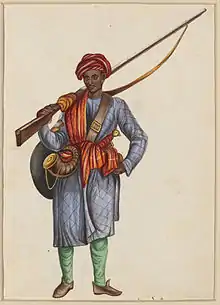Army of the Mughal Empire
The Army of the Mughal Empire was the force by which the Mughal emperors established their empire in the 15th century and expanded it to its greatest extent at the beginning of the 18th century. Although its origins, like the Mughals themselves, were in the cavalry-based armies of central Asia, its essential form and structure was established by the empire's third emperor, Akbar.
| Mughal Army | |
|---|---|
 Flag of the Mughal Empire | |
 Great Mogul And His Court Returning From The Great Mosque At Delhi India – Oil Painting by American Artist Edwin Lord Weeks | |
| Founded | late 15th century |
| Disbanded | 1805 |
| Leadership | |
| Commander-in-Chief | Mughal emperor |
The army had no regimental structure and the soldiers were not directly recruited by the emperor. Instead, individuals, such as nobles or local leaders, would recruit their own troops, referred to as a mansab, and contribute them to the army.
Origin
The Mughals originated in Central Asia. Like many Central Asian armies, the mughal army was horse-oriented. The ranks and pay of the officers were based on the horses they retained. Babur's army was somewhat small and looked like an army of Afghan origin. Akbar restructured the army and introduced a new system called the mansabdari system. Later emperors followed this system.
Organisation and troop types
Mughal emperors maintained a small standing army. They numbered only in thousands. Instead the officers called mansabdars provided much of the troops.
Standing army

The Mughal Emperors maintained small standing armies. The emperor's own troops were called Ahadis. They were directly recruited by the Mughal emperor himself, mainly from the emperor's own blood relatives and tribesmen. They had their own pay roll and pay master, and were better paid than regular horsemen sowars.
They were gentlemen soldiers, normally on administrative duties in the palace. They also included palace guards, the emperor's own body guards-shahiwalas, and gatekeepers. They were better equipped and had their own horses. The emperor also maintained a division of foot soldiers and had his own artillery brigade.
Mansabdars

Akbar introduced this unique system. The Mughal army had no regimental structure. In this system, a military officer worked for the government who was responsible for recruiting and maintaining his quota of horsemen. His rank was based on the horsemen he provided, which ranged from 10(the lowest), up to 5000. A prince had the rank of 25000. This was called the zat and sowar system.
An officer had to keep men and horses in a ratio of 1:2. The horses had to be carefully verified and branded, and Arabian horses were preferred. The officer also had to maintain his quota of horses, elephants and cots for transportation, as well as foot soldiers and artillery. Soldiers were given the option to be paid either in monthly/annual payments or jagir, but many chose jagir. The emperor also allocated jagir for maintenance of the mansabs.
Branches
The Mughal army had no real divisions, though it had four types of warriors: cavalry, infantry, artillery and navy. The cavalry held the primary role, and the others were auxiliary.
Cavalry
.jpg.webp)
The cavalry was the most superior branch of the Mughal army. The horsemen normally recruited by mansabdars were high class people, and were better paid than foot soldiers and artillery men. They had to possess at least two of their own horses and good equipment. Normally they used swords, lances, shields, more rarely guns. Their armour was made up of steel or leather, and they wore the traditional dress of their tribes. The regular horseman was called a sowar.
Mughal cavalry also included elephants, normally used by generals. They bore well ornamented and good armour. Mainly they were used for transportation to carry heavy goods and heavy guns. Some of rajput mansabdar provided camel cavalry also. They were men from desert areas like Rajastan.
The key to Mughal power in India was its use of warhorse and also its control of the supply of superior warhorses from Central Asia. This was confirmed by victories in the Battle of Panipat, the Battle of Machiwara, Battle of Dharmatpur, and in eyewitness accounts such Father Monserrate, which primarily featured the use of traditional Turko-Mongol horse archer tactics rather than gunpowder.[1] Cavalry warfare came to replace the logistically difficult elephant warfare and chaotic mass infantry tactics. Rajputs were co-opted by converting them into cavalry despite their traditions of fighting on foot. This was similar to the Marathas' service to the Deccan Sultanates.[1]
Infantry

The infantry was recruited either by Mansabdars, or by the emperor himself. The emperor's own infantry was called Ahsam. They were normally ill-paid and ill-equipped, and also lacked discipline. This group included bandukchi or gun bearers, swordsmen, as well as servants and artisans. They used a wide variety of weapons like swords, shields, lances, clubs, pistols, rifles, muskets, etc. They normally wore no armour.
The infantry, locally recruited and equipped with matchlocks, bows and spears, were despised so much that they were virtually equated with litter bearers, woodworkers, cotton carders in the army payrolls. Chronicles hardly mention them in battle accounts. Their matchlocks were thrice as slow as the mounted archers. This remained the case until the British started recruiting and training their own armies in India.[2]
Artillery

The artillery was an important branch of the Mughal army. It was used extensively by early Mughal rulers, like Babur, who used it to establish the Mughal Sultanate in the Indian subcontinent.
Mughal artillery consisted of heavy cannons, light artillery, grenadiers and raketies. Heavy cannons were very expensive and heavy for transportation, and had to be dragged by elephants into the battlefield. They were somewhat risky to be used in the battlefield, since they exploded sometimes, killing the crew members. Light artillery was the most useful in the battle field. They were mainly made up of bronze and drawn by horses. This also included swivel guns born by camels. They were very effective in battlefield. But gradually, the cannons lost their importance as they proved to be much obsolete when compared to European cannons built of iron.
Navy

The navy was the weakest and poorest branch of the Mughal military. The Empire did maintain warships, however they were relatively small. The fleet also consisted of transport ships. The Navy's main duty was controlling piracy, but they were also used in war.[3]
Chelas
Chela were slave soldiers in the Mughal army. As a counterpoise to the mercenaries in their employ, over whom they had a very loose hold, commanders were in the habit of getting together, as the kernel of their force, a body of personal dependents or slaves, who had no one to look to except their master. Such troops were known by the Hindi name of chela (a slave). They were fed, clothed, and lodged by their employer, had mostly been brought up and trained by him, and had no other home than his camp. They were recruited chiefly from children taken in war or bought from their parents during times of famine. The great majority were of Hindu origin, but all were made Mahomedans when received into the body of chelas. These chelas were the only troops on which a man could place entire reliance as being ready to follow his fortunes in both foul and fair weather.[4]
Like the Timurids and other Mongol-derived armies, and unlike other Islamic states, the Mughal empire did not use slave soldiers prominently. Slave soldiers were mainly placed in very lowly positions such as manual labourers, footmen and low-level officers rather than professional elite soldiers like Ghilman, Mamluks or Janissaries. However, eunuch officers were prized for their loyalty.[5]
See also
References
- André Wink. The Making of the Indo-Islamic World c.700–1800 CE. University of Wisconsin, Madison: Cambridge University Press. pp. 165–166.
- André Wink. The Making of the Indo-Islamic World c.700–1800 CE. University of Wisconsin, Madison: Cambridge University Press. p. 164.
- Roy, Atul Chandra (1972). A History of Mughal Navy and Naval Warfares. World Press.
- Sharma, S. R. Mughal Empire in India: A Systematic Study Including Source Material. p. 11.
- Bano, Shadab (2006). "MILITARY SLAVES IN MUGHAL INDIA". Proceedings of the Indian History Congress. 67: 350–57.
![]() This article incorporates text from The army of the Indian Moghuls: its organization and administration, by William Irvine, a publication from 1903, now in the public domain in the United States.
This article incorporates text from The army of the Indian Moghuls: its organization and administration, by William Irvine, a publication from 1903, now in the public domain in the United States.
Further reading
| Wikimedia Commons has media related to Military history of the Mughal Empire. |
- Edwardes, Stephen Meredyth; Garrett, Herbert Leonard Offley. Mughal Rule In India.
- Sharma, S. R. Mughal Empire in India: A Systematic Study Including Source Material.